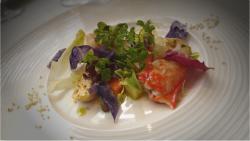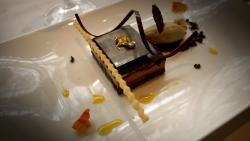 I despair of financially overwrought restaurant wine lists. I’m thinking of the tomes where the filth at the bottom bullies the food and bruises your palate, whilst the juvenile bottles in the dear, dear distance are too tannic to drink. They’re transparently indicative of the lazy restaurateur, sommelier with shot taste buds and/or chef with negligible interest in anything mysteriously made of fermented grapes…
I despair of financially overwrought restaurant wine lists. I’m thinking of the tomes where the filth at the bottom bullies the food and bruises your palate, whilst the juvenile bottles in the dear, dear distance are too tannic to drink. They’re transparently indicative of the lazy restaurateur, sommelier with shot taste buds and/or chef with negligible interest in anything mysteriously made of fermented grapes…
Fortunately, as a tasting of the wines of one Manuel Fariña proved, good taste can come cheap, even from a region tipped by massively influential wine critic, Robert Parker as one of Spain’s top three for tinto…
Over a not so light lunch at ‘Apsley’s’ at The Lanesborough, the wine world’s literati congregated to consider the wines above an incongruous muzac of something like house under space station like chandeliers beside an unfinished smudge of a fresco. In monogrammed shirt authoritatively equipped with two pens in pocket, the tanned, silver haired Fariña precisely explained how he kick-started ‘the revolution’ in one of Spain’s oldest winemaking regions. The remote 5,000 hectare ‘oasis’ of coarse sand, dark clays and rugged ‘puddingstones’ fleetingly punctuates the northwest of Castile and Léon. Gentrified in the late 1980’s as ‘DO Toro’, the area has been pinpointed by over 50 new prospectors in the last decade alone.
Feeling the Heat
Fariña told how in a region where temperature control not long ago meant diverting the chilly river to flood cellars, he pioneered use of sparkling stainless steel in a brand new winery whilst his friends clung on to cement cuves. He also brought his harvest closer by three weeks, bought a de-stemmer and sewed vines densely to exert them. Cutting no corners, when grapes need to see wood, their bounty is matured in new US, and in some cases, French oak casks. Today, Fariña’s sons continue to navigate the relentless journey of modernisation, converting the family’s 300 hectares to an organic philosophy.
Implementing such factors directly contributes to fresher, more aromatic wines that are balanced not behemoth. Fariña describes this approach as ‘taming the Toro beast.’ That the terrain is so tough fortunately means the aphid vine-devastator, Phylloxera Vastatrix poses only a minimal threat. Vines therefore don’t need to be grafted onto resistant rootstocks, meaning in their natural state, they are longer lived, chanel more energy into grapes and wellbring, and therefore remain substantially disease resistant.
 As six immaculate servers settled eight gold fringed plates of beautiful but undistinguished fishy amuse bouches on our table, ‘Decanter’ writer luminary, Stephen Spurrier whispered something about how hotels like The Lanesborough solve an employment crisis. But more interesting than chef, Heinz Beck’s prescribed plated seabed was Fariña’s sparkling Malvasia. Made in minute quantity, it was spring fresh, weaving white flowers and pumace into a dense, long-lived finish. The fine flute represents Fariña’s desire to secure plots of the grape in a region where fellow producers are grubbing them up in lieu of money-maker, Tinta del Toro (the local name for the Tempranillo grape). Fashion, said Fariña, has never been his concern.
As six immaculate servers settled eight gold fringed plates of beautiful but undistinguished fishy amuse bouches on our table, ‘Decanter’ writer luminary, Stephen Spurrier whispered something about how hotels like The Lanesborough solve an employment crisis. But more interesting than chef, Heinz Beck’s prescribed plated seabed was Fariña’s sparkling Malvasia. Made in minute quantity, it was spring fresh, weaving white flowers and pumace into a dense, long-lived finish. The fine flute represents Fariña’s desire to secure plots of the grape in a region where fellow producers are grubbing them up in lieu of money-maker, Tinta del Toro (the local name for the Tempranillo grape). Fashion, said Fariña, has never been his concern.
Advised by an earnest waiter to only attack it with the shell-edged spoon, I found black skate stuffed squid ink fagotelli (akin to ravioli) visually striking, but again, rather bland. Fortunately the next wine was again a delight. Even without bubbles, the still Malvasia was clean, fresh and stone-fruit scented. A charming white for a charming RRP of £7.99, posed Spurrier. And I agreed. Alas, Apsley’s pretty and probably pretty expensive elaborately twirled glassware constrained rather than enhanced its delicate fragrance.
Inhabited by what looked like green mice (avocado paste), pappa al pomororo translated on the plate as beef fillet tartare eclipsed by abundant tomato innards. The dish made the comedic impression of tomato pizza deprived of its base. Fortunately, Tinta de Toro ’09 was a vivid palate cleanser, scything through the acidic tomatoes with its oak free coffee and chicory perfume followed by fresh, pervasive, berry-stained palate. It eventually puckered to a crisp, dry finish. (RRP £7.99).
Starred Cook Cooks for the Stars
Fortunately, the cooking of Beck’s London chef, Massimiliano Blasone, was about to embolden. ‘Intercourse’ of rabbit and asparagus ravioli was fleshy and invigorating. Indeed, bursting the parcels with my teeth, I think I ‘got’ why Michelle Obama rated the carbonara version which she gorged during G8 at Beck’s three star mothership, ‘La Pergola’ in Rome.
To cope with the sudden escalation of flavour flown in by tenderly roasted pigeon ‘royal’, lobe of foie gras, pearl onions and mustard seed sauce (one of few asterixed on the menu as a ‘Heinz Beck signature dish’) we entered oak bevelled territory via the glass. Gran Colegiata Crianza French Oak ’06 was the most elegant example of Toro red I’ve sampled from this normally less than retiring region. It offered a sense of savoury balsamic and cassis wafts, being more evocative of a warm year in Bordeaux than wild Toro. (RRP £12.99). It mingled seamlessly with the gamey fug of the sanguine suggestion of the juicy French bird. Following, a briar scented, soulful, still fresh Gran Reserva ’89 intoxicatingly dove-tailed with a sundial of cheeses, but not their unnecessarily flamboyant pastes.
 With the whimsical but delightful chocolate and coffee fondant tile came adornments of flower buds and doubly tasteless gold flecks. Val de Reyes Dulce NV, a mellow, sparsely textured, black-fruit stained Tinta del Toro blended with the cocoa richness.
With the whimsical but delightful chocolate and coffee fondant tile came adornments of flower buds and doubly tasteless gold flecks. Val de Reyes Dulce NV, a mellow, sparsely textured, black-fruit stained Tinta del Toro blended with the cocoa richness.
Fariña’s Spanish wines had held their own against a fairly strident interpretation of German accented Italian cuisine in the British conservatory served by people from a whole range of nationalities. In a similarly steadfast way, when faced with the no doubt gargantuan bill for lunch for eight at The Lanesborough, I didn’t note a mote of melancholy sweep his face…
Bibendum Wines are Fariña’s UK importer
Apsley’s at The Lanesborough – Hyde Park Corner, London. SW1X 7TA
